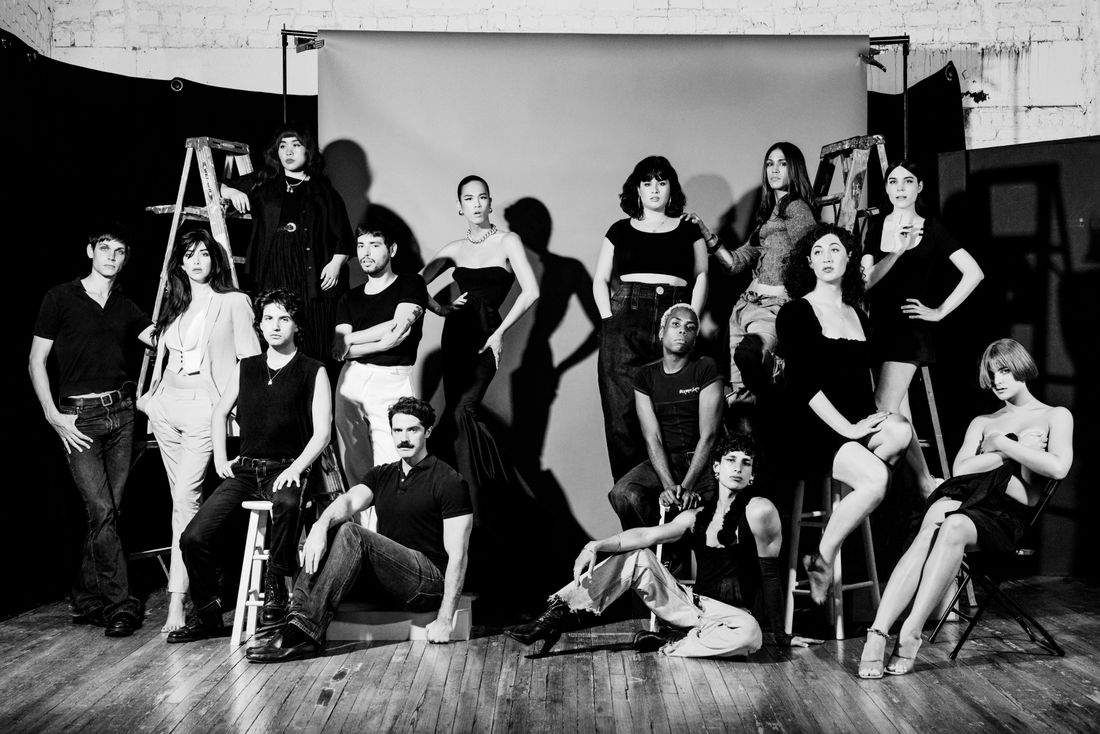
The children of fashion Tumblr came to New York, as fashion strivers often do, from the less fashionable provinces: San José and Grand Rapids and Baltimore and Orange County and the Jersey Shore. Growing up far from the industry’s enclaves, they obsessed over Balenciaga ads and Vogue Italia scans online, following along with the zeal of outsiders, and found their like-minded zealots to befriend. A decade later, they all live in New York, and they remain friends. They socialize together and party together, and now, having made it from the digital outside to the industry inside, they work together too. “The first time I met all the dolls, it was made clear, this was a tight group of ride-or-dies,” says the artist Martine Gutierrez, who met her crew in the city following a Candy magazine shoot in 2016 and quickly fell in.
They’ve come a long way since they were on Tumblr, the image-centric blogging platform, in the 2010s as fashion-obsessed teenagers. Fluent in technology, controlling their own means of image production, distribution, and promotion: the Factory girls without the need for a Warhol, the Halstonettes if they dispensed with Halston, the unholy love children of Cleveland (Pat, not Ohio) and Vreeland. They’ve internalized Polly Mellen rhapsodizing about “weightless, pom-pom, powder-puff” faux furs in Unzipped and Donatella Versace making marble-mouthed pronouncements in a Vogue video interview (“What are you reading right now?” “Magazines!”). They live to be behind the camera and in front of it.
Without fashion school — in some cases, without even finishing high school, much less college — they educated themselves in the chapter and verse of the industry, its history and its archives as well as its lingua franca. Their styles were cooked in Tumblr’s mix-and-match, endlessly referential crucible, and the most devoted could spend five or six hours a day on the platform, posting and commenting. “After midnight was the time to be on there,” says Devan Díaz, a writer who left Tennessee for New York at 18 and started her Tumblr in 2009. “If you stayed up really late, then you could catch the European crowd waking up.”
“If I didn’t have Tumblr, I never would have gotten into fashion,” says Marcus Cuffie, a stylist whose Tumblr, Dustulator (the name of a favorite Rick Owens collection), begun in 2011, became a touchstone for many fellow bloggers. “I wouldn’t have known how to access it.”
“I think we wanted to know why we liked the things we liked,” says Hari Nef, who moved to New York from Massachusetts to attend Columbia and joined Tumblr in the summer of 2011, just before she arrived. “We wanted to trace a line through the past to figure out where it came from. Together, we were able to kind of thread that needle and string it along. It was about information, and it was about discovery — discovery that you couldn’t achieve without community.” Reblogs and comments led to chats and calls, and gradually a circle coalesced.
All the research paid off. Nef interned at cool fashion places like VFiles, although now she’s better known as an actress; she spent this spring shooting the Barbie movie. (She deleted her Tumblr before her first film came out in 2018.) Cuffie now styles for Harper’s Bazaar, Dazed, and a grab bag of indie mags. Cruz Valdez, who became Cuffie’s partner and now collaborator, is a photographer who shoots for Marc Jacobs, Rihanna’s Savage x Fenty, and Eckhaus Latta. “These kids know things,” says Mel Ottenberg, the editor-in-chief of Interview, who hired one of them, Dara Allen, known professionally as Dara (Tumblr b. 2011), to be the magazine’s fashion director this February. “They must really study.”
For younger millennials and all of Gen Z, making friends online is just how you make friends. But eventually, this crew realized, you have to meet up in real life if you want to get anything done. Their Tumblr pals were their support system, and they flocked to the city in formation to live, work, and play together. “I always kind of wanted to come to New York, but I don’t think I would have,” says Allen. But goaded by fellow Californians Valdez and Iris Diane Palma, an artist, she bought a ticket with them (in tears) and moved to a flop in Bushwick. (Stevie Triano, another Tumblr friend, and Cuffie picked up the keys and met them there the day they arrived.) Valdez, who went to photo school, did her first shoots in their shared Brooklyn apartment with a seamless backdrop rigged up by a belt to their futon with Allen, who appeared in two Marc Jacobs shows before finally signing with a modeling agency, as her subject.
In New York, they met other Tumblrites, including Nef and Cuffie. “It really felt like we were all meant to find each other,” Nef told me. “The word manifesting was really popular at that time. And that’s what we felt like we were doing. Obsession alone wasn’t enough for me, nor was it enough for Dara or Cruz or Marcus or Devan or any of us. It simply would have been a waste for us to do anything else but use all of those hours that we spent looking and listening and writing and sharing and not trying to make something with them.”
They ended up friends with Ethan James Green, a model turned photographer, and the circle expanded. Green was a more casual Tumblr user whose runway career was cataloged on Tumblr — most exhaustively by Allen on her blog. His photography career was stalling until, inspired by his mentor David Armstrong, he began shooting black-and-white portraits of friends and friends-to-be, including every person pictured here, many of whom are featured in his first book, Young New York. “All these big fashion people that I’d been around for years all of a sudden were like, ‘Oh!’ — it turned something on,” Green says. “People started asking me to do my pictures. And because I was able to really create my world, I didn’t have to compromise.” These days, he shoots for Vogue and W, Louis Vuitton campaigns, and just closed his first solo show at Fotografiska.
Now they are members of fashion’s next generation, landing big jobs. Green often works with Allen. Allen often works with Valdez. Valdez often works with Cuffie, who is also her partner. Their friends assist on shoots or do the hair or build the sets. Their work adorns billboards over Soho for Calvin Klein; they’re booked by Bottega Veneta and Alexander McQueen. The line between work and life can be blurry. They don’t work exclusively together, but they understand each other better when they do. “We all see it for each other. Our Grindr profile would say, ‘Muse 4 Muse,’” Gutierrez says. “I bring friends into projects constantly, especially when there’s a budget.”
“There is a shared language for sure,” says Marcs Goldberg, an art director who designs sets for photo shoots. “It’s very much like a sibling relationship, where it can be very intense and extreme, but in the end, it’s exactly as it should be.”
They have come into their own individually and collectively, carving out space for themselves and their taste. Many of them have transitioned since their earliest meetings on Tumblr or embraced non-binary identities. “It’s opened up so many possibilities,” Valdez told me. “We all had such an instinct toward something,” Allen says. “I think I’ve realized that it really becomes easier just to go with your gut — and your friends.” This year, she worked with Green on an ad campaign for Walmart. “To think about someone in middle America seeing style from her perspective is really crazy,” Green says proudly.
To hear them tell it, their work now is not so different from their Tumblr ’fit pics. “I think it’s all just been about building and refining,” Valdez says. “When I think about my older work, it’s not like, it’s so drastically different in ways, it’s just more about how I’ve been able to articulate what I wanted to say and how to say it.” “This was me on Tumblr,” Allen cried as she struck a pose for the camera, swiveling her wrists outward and clamping her hands to her waist, a haute little teapot. Now their Tumblrs have mostly fallen away — although a few still post privately or occasionally — and the platform itself has faded from its former glory. The next generation is assembling itself elsewhere.
But if their medium has waned, the message hasn’t. What would they do on their last day on earth? Probably this, they said, sitting for this portrait. There is no “cheese” here. “Everybody say ‘cunt,’” Valdez said before the shutter snapped. “Cunt!” they all bellowed joyfully.





